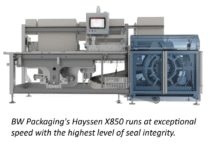Gea has completed its D-tec valve range with the double-chamber valve D/DV. According to the press release, the valve is a special double-seat valve in which the leakage chamber is designed as a sterile chamber and hermetically separated from the environment by two side valves. The sealing properties of the stem diaphragm make it possible to increase the shelf life of soft drinks, fruit juices, milk-based and lactic acid fermented products. If manufacturers adopt the process chain accordingly, D-tec enables them to achieve the desired shelf life of a product even with fewer preservatives. The diaphragms are made of a thermoplastic that is more flexible than stainless steel.
Equip process plants from A to Z with D-tec
With the double-chamber valve D/DV, GEA completes its still young valve program, so that customers can now fully equip their production processes with D-tec. “Equipping the interfaces in process plants with as few valve types as possible is often a decisive criterion for our customers. The more different valve series have to correspond, the more complex the spare parts handling and warehousing becomes,” explains product manager Pascal Bär, who looks after the aseptic valves at GEA. After the single-seat control valve D-tec P/DV in 2018, GEA now presents the last piece of the puzzle for the D-tec range – the double-chamber valve D/DV. GEA can therefore consistently plan greenfield projects with D-tec; a retrofit for the single-seat valve is available for existing plants.
Hygiene philosophy implemented
With the D-tec double-chamber valve, GEA now offers aseptic valves for both hygiene classes “Aseptic” and “UltraClean”, which are tailored to the special conditions of the respective applications. GEA recommends this distinction according to its hygiene philosophy: “Aseptomag – our stainless-steel bellows technology – is the premium class of aseptic valve technology, which we recommend for highly sensitive products such as baby food and UHT milk. These require uncompromising aseptic execution of the processes and components,” says Bär. “But a large proportion of the beverages produced by our customers are not conveyed under aseptic conditions but fall into the second-highest hygiene level according to the VDMA guideline, which is hygiene class IV, UltraClean. Our new double-chamber valve in the D-tec line is precisely tailored to the process requirements of this hygiene class”. D-tec is ideally suited for products such as iced tea, fruit juice, fruit yogurt, and ESL milk, where product parameters such as pH value, cold chain, storage, and shelf life play a decisive role.
Ensure operational safety
The heart of every D-tec valve is the hermetically sealed D-tec stem diaphragm, which offers a higher contamination protection against the atmosphere and thus ensures the microbial stability of the product throughout the entire process. The diaphragms are made of thermoplastic which is more flexible than stainless steel. For example, it can compensate for pressure hammers and, to a certain extent, forgive process failures, says Bär. If a diaphragm should break, leakage detection still ensures a high level of operational reliability. In addition, the maintenance-friendly design minimizes system downtimes.
Adapting demanding process conditions
Like the entire D-tec valve line, the D/DV double-chamber valve is based on the proven Varivent modular system, which is characterized by its adaptability. This allows the valve to be configured according to the process conditions. Characteristic of this double-seat valve are the two diaphragms which hermetically seal the interior of the product from the atmosphere.
IndiFoodBev — authentic, impactful and influential
An English-language food and beverage processing and packaging industry B2B platform in print and web, IndiFoodBev is in its third year of publication. It is said that the Indian food and beverage industries represent approximately US$ 900 billion in revenues which implies more than 20% of the country’s GDP. Eliminating the wastage on the farmside can help to deliver more protein to a higher number of the population apart from generating sizable exports. The savings in soil, seeds, water, fertilizer, energy and ultimately food and nutrition could be the most immense contribution that country is poised to make to the moderation of climate change.
To improve your marketing and grow sales to the food and beverage processing and packaging industry, talk to us. Our research and consulting company IppStar [www.ippstar.org] can assess your potential and addressable markets in light of the competition. We can discuss marketing, communication, and sales strategies for market entry and growth.
Suppliers and service providers with a strategy and budget for targeted marketing can discuss using our hybrid print, web, video, and social media channels to create brand recognition linked to market relevance. Our technical writers are ready to meet you and your customers for content.
The second largest producer of fruit and vegetables in the world is continuously expanding processing capacities and delivery systems with appropriate innovative technologies. We cover product and consumer trends, nutrition, processing, research, equipment and packaging from farm to thali. Get our 2025 media kit and recalibrate your role in this dynamic market. Enhance your visibility and relevance to existing markets and turn potential customers into conversations. Ask for a sample copy of our bi-monthly in print or our weekly IndiFoodBev eZine each Wednesday.
For editorial info@ippgroup.in — for advertisement ads1@ippgroup.in and for subscriptions subscription@ippgroup.in
Naresh Khanna – 10 February 2025
Subscribe Now












